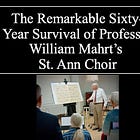Part II: "The Remarkable Sixty-Year Survival of Professor Mahrt's St. Ann Choir"
Here begins history of the founding of the choir, in Professor Mahrt’s words:
“On the 19th Sunday after Pentecost in 1963, a new choir began to sing for a High Mass at St. Ann Chapel, the Newman Center for Stanford in Palo Alto. . . .
“The choir was founded by William F. Pohl who had sung chant in school and college and who had begun a chant Mass at Berkeley when he was a doctoral student. He came to Stanford as a junior faculty member in mathematics and proposed the chant Mass for St. Ann Chapel. . . .
“He saw in the highest liturgical music . . . a preeminent goal—to effect in the listener a joy very much akin to the delight of intellectual discovery,’ something which led Medieval musicians to compose music according to geometric principles, and also led to harmony as we know it today.
“Later music sometimes aimed less at contemplative joy, than at dramatic effect, or simply at pleasing the hearers. The liturgy should be first and foremost contemplative—only when this is achieved will excesses be avoided which replace contemplation with activity, ceremonies with mere pageantry.”
The summer before Pohl started the St. Ann Choir, Mahrt and Pohl had met each other by chance, again according to Mahrt’s account.
“I was a graduate student in music at the University of Washington, singing chant for Masses at churches in Seattle. During the Summer, when choirs were on vacation a group of us prepared a polyphonic Mass and sang it on the last Sunday of July at the local Dominican church, the only Mass we sang the whole summer. After the Mass there appeared William Pohl, who was attending a mathematics conference, the only one that summer. He told me he was beginning a chant choir at Stanford, and I surprised him by saying I would go to Stanford as a graduate student in the Fall. I thereby was at the rehearsal of the new St. Ann Choir and its first Mass. The new choir was for a High Mass sung by the priest, with Gregorian chant propers by the choir, Gregorian chant ordinary for the congregation [which the choir also sang], occasional motets in classical polyphony, and organ music.”
In the slide, William Pohl is alone in the two photos on the left, with a cigar in his mouth in both photos! A post-it note from Mahrt identifies the top left photo, “Bill Pohl plays Jane Sugarman Harpsichord.”
In the top right photo, Pohl is on the left, and Mahrt (a graduate student at the time) is in the middle. In the bottom right photo, Pohl is in the middle and Mahrt is on the right. In all the photos from when Mahrt was a grad student, you can see he, characteristically, wore a suit and tie.
When the St. Ann Choir started, the Second Vatican Council was just beginning. The Mass of 1969, which is now the norm was six years away. All the Masses at that time were in the form of what is now called the traditional Latin Mass, the Extraordinary Form of the Mass, or the Vetus Ordo. The traditional Latin Mass, which was the only form of the Mass in the Roman rite, was celebrated according to the newly reformed Missal of 1962, which is called the Missal of John XXIII.
Experimentation during Masses was rampant in many places, and it was often quite distracting from the sacrifice of the Mass. Some priests seemed to think that since improvisation was allowed, it was actually required.
Here’s a sampling from my experience. One kind of musical improvisation I heard of when I lived in Minnesota was the use of polka Masses celebrated for the Polish Governor. At the parish closest to the University of Minnesota, the Masses were accompanied by hippy musicians playing folk songs.
Pohl believed liturgy should foster contemplation, and Gregorian chant was the ideal form of music for the purpose. His original plan was for the choir to continue to sing the normal Latin Mass of 1962 with Gregorian chant. Professor Pohl played the organ.
Soon after the choir’s creation, Pohl’s convictions were reinforced by the December 4, 1963 publication of Sacrosanctum Concilium, the Constitution on Sacred Liturgy. This was the first formal document issued by the Second Vatican Council.
In Sacrosanctum Concilium, Gregorian chant sung in Latin was mentioned as the normative music. Renaissance polyphony was given special praise, and the pipe organ was identified as the ideal sacred instrument.
The puzzling thing to realize is that these instructions were almost universally ignored ever since.






